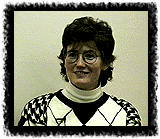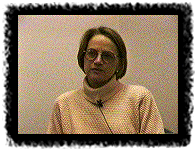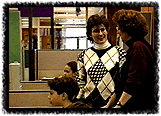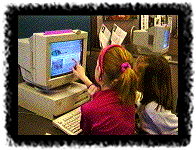 Margaret Holtschlag is teaching
fourth grade at Murphy Elementary in Haslett, Michigan. She has been working in
Haslett for the past nine years. Altogether, Margaret has been teaching for
eighteen years, although she can't believe that it's been that long. She also
has taught first, second, and fifth grades. She taught for two years in both
Minnesota and Lansing, Michigan and spent six years teaching in Laingsburg,
Michigan. Margaret likes teaching in Haslett because it gives her the chance to
grow. She has a Master's degree in Reading Instruction from Michigan State
University, where she focused on cooperative learning, integrated curriculum, and
alternative assessment. Margaret has conducted training for classroom management
and cooperative learning, and has also presented at several conferences for
reading and technology. Margaret, along with Carol Trojanowski, serves as
chairperson for two committees (Publications and Public Relations) for the
Michigan Reading Association.
Margaret Holtschlag is teaching
fourth grade at Murphy Elementary in Haslett, Michigan. She has been working in
Haslett for the past nine years. Altogether, Margaret has been teaching for
eighteen years, although she can't believe that it's been that long. She also
has taught first, second, and fifth grades. She taught for two years in both
Minnesota and Lansing, Michigan and spent six years teaching in Laingsburg,
Michigan. Margaret likes teaching in Haslett because it gives her the chance to
grow. She has a Master's degree in Reading Instruction from Michigan State
University, where she focused on cooperative learning, integrated curriculum, and
alternative assessment. Margaret has conducted training for classroom management
and cooperative learning, and has also presented at several conferences for
reading and technology. Margaret, along with Carol Trojanowski, serves as
chairperson for two committees (Publications and Public Relations) for the
Michigan Reading Association.
Margaret has also been writing for thirteen years. Together with Carol Trojanowski she co-authors the Random House Calendar for Kids, which features activities for parents and children to celebrate every day.
She first learned about technology from her husband, who is a United States Geological Survey hydrologist. Her interest in technology stemmed from her desire to explore new and different ways to approach teaching in her classroom. She and her husband received an Excellence in Education grant from the Department of the Interior to do a multi-media project on wetlands.
Cindy Lafkas is teaching fifth grade at Cornell
Elementary in Okemos, Michigan. Cindy does not describe herself as a "techie,"
saying she couldn't remember how to run a movie projector from one year to the
next. Cindy wouldn't have become involved with computers if it hadn't been for
word processing, since she loves to write. Prior to teaching at Cornell, she
taught in the Special Education program at Michigan State University. Cindy
also taught in several other school districts in Michigan, as well as in Iowa and
at Kuwait International School. When she first came to Cornell, she worked as a
resource teacher. Cindy also taught third and fourth grades. She has been at
Cornell for eleven years.

Project Description: Field Trips
Cindy and Margaret have participated in four telecommunications field trips through TCI and Turner Adventure Learning (see Web Resources below) in the past three years. This year, they went to Ellis Island. In the past they have gone to the Rift Valley in Kenya and the battle field at Gettysburg.

You can hear an excerpt from an interview with Cindy Lafkas about the usefulness of
Electronic Field Trips in her classroom.
Hear an audio Clip from the Interview (552K .AU
Sound file).
Before starting a field trip, Cindy and Margaret talk about how the trip integrates with their curriculum goals and guidelines. The field trip then becomes a major curricular focus before, during, and after the broadcast. Turner Adventure Learning provides many resources for teachers, such as curriculum guides, lesson plans, and primary source materials. The trips are interactive, with students participating during the broadcast through phone/e-mail questions and chat rooms with experts. During the field trips, students know that their questions will be asked, if not by them, then by other students. Cindy and Margaret found that at the end of the three day trips students could answer questions like experts. They also appreciate that the trips show kids that adults are interested in and concerned with their work and thinking. Cindy and Margaret have their classrooms collaborate via telecommunications after the broadcasts to share information and special extensions (e.g., in-class visitors). Cindy and Margaret understand that the richness of the field trip is not the actual broadcast but what it allows them to do afterwards through research and sharing.
The trip to Ellis Island. Margaret and Cindy laid
the ground work for their trip to Ellis Island starting at the beginning of the
school year. They had students assume a persona from the past to follow through
the immigration journey. In some cases, the persona is from the country where
the student's own family came from. As part of this work, students have been keeping
a fictional journal on the person. They are also packing bags and writing to the
steamer company to arrange their passage to the U.S. Several classrooms in each
building join together to do a reenactment of a day at Ellis Island
with all the classes involved.

Teaching Philosophy
Cindy enjoys being a facilitator and helping children learn how to think and learn. She tries to make learning an exciting adventure for her students, where they explore new ideas.
According to Margaret, "Each experience that I plan for my students should have three key elements: significance, joy, and celebration. I know I can't achieve these elements in every lesson, but it is my driving goal.
"When I plan units of study, the topics of study need to be meaningful, and planted in the real world whenever possible. It is a matter of striving for interconnectedness between the required fourth grade curriculum and the events that shape the students lives. For instance, the environmental concerns about the wetlands in our community are woven in our science unit, and the sports records of the Pistons are interspersed in math concepts. When these real events have significance in the students lives, the action of learning makes sense.
"I think students learn so much more when they are having fun, so JOY is the second critical component. You can see the joy when a child gets that sense of "A-HA!" when solving a problem, or discussing a topic with classmates. You can hear the joy when students share information about a book, or a strategy in science or math. When a student pursues learning just for the sake of learning, the joy is there. And that's a lifelong quality, so essential in learners. So, when I plan lessons, I actively seek to put joy into the event.
"Celebration takes place in many forms with
many people. I think that children learn best in an atmosphere of action and
interaction, of reflection and conversation. Each time students take what they
know, and share it with classmates, that's a celebration of learning. A lively
classroom is the audience for the celebration of learning, so I strive to create
an atmosphere in which students have many opportunities to talk, draw, act out,
and create new things from what they are learning."

Internet Philosophy
 Cindy views the Internet as a source of information
for
her students. She strives to teach them how much information is available from
the Web and how to access it. She also emphasizes the importance of ethical use
of information from the Internet. She helps students apply and develop critical
thinking skills as they make decisions about which pieces and types of
information they garner from the Internet.
Cindy views the Internet as a source of information
for
her students. She strives to teach them how much information is available from
the Web and how to access it. She also emphasizes the importance of ethical use
of information from the Internet. She helps students apply and develop critical
thinking skills as they make decisions about which pieces and types of
information they garner from the Internet.
According to Margaret, "Technology is simply a tool that we use when we learn, and my students are finding that it's a tool that they reach for more and more frequently, and with growing ease. By using the Internet, they can research events that are significant to them, experience the fun of finding information, and share that information with classmates."

Here two classmates excitedly share and discuss the information about the results of
overpopulation they found on the Web.
The video clip (1,008K QuickTime Movie
file)
Audio only of the clip (336K .AU Sound file)
"Technology offers them the opportunity to be creative in their presentation of information, and challenges them to consider a wider audience for their topics of study. For instance, while my students are learning about Native Americans of the Great Lakes, they are sending their information to keypals in Gillette, WY, and comparing information with these students who researched similar topics in their state. It is a celebration when the children know that they have a two way communication with almost anyone in the world, for almost any topic they want to learn about. I've been using the Internet daily in the classroom, with the frequency that we used to have in just visiting the library to find an answer to a question. I want the children to have a huge variety of ways to get information, and the use of technology really broadens their perspective."

In 1993 TCI Cablevision, The Children's Network/Voyager, and Fred D'Ignazio of Multi-Media Classrooms Inc. (see Web Resources below), started talking about how to help students access information using new technologies such as e-mail, interactive cable, and computer conferencing. Out of these discussions came a meeting with a number of teachers who had been recruited from the Lansing area, where Margaret and Cindy met for the first time. The group of teachers and technology providers worked together to brainstorm how they could achieve their goals.
The program, called Mulit-media Detectives, sought to
support teachers interested in the Internet and their students acquire
"technological skills, problem-solving strategies, and experiences accessing and
generating information through cable television, electronic mail services, and
computer assisted publishing." The project integrated interactive cable links,
e-mail, computer conferencing or chats, and various television programs. The
two major themes of the group were access and dissemination of information. The
technology providers supplied the hardware and worked with the teachers to help
them try out new ideas and strategies for integrating the technology in their
teaching. The businesses also provided training and support as well as e-mail accounts.
Margaret and Cindy are still receiving significant support from their business
partners.

Classroom Equipment
Margaret has a Macintosh in her classroom. She also has a newer computer on order that will be better able to run Netscape. Her classroom has a TV and a VCR which were purchased by the district. Margaret's classroom also receives Channel Works from TCI. Students use the computers to learn keyboarding and application software. They also use the computer in the classroom for more general purposes, like word processing, and telecommunications. In addition, Murphy Elementary currently has a computer lab with 14 Macintosh computers that have already reached their capacity.
At the time that Cindy started at Cornell, the school had
a number of Apple IIe computers. Several teachers convinced the administration
to group the machines together in a lab. The lab was used by each class about one
hour each week. Students started working on keyboarding in 1st grade. Cornell
has also added another lab of IBM PC's, twelve of which are networked, and four
multi-media centers. Cindy also has a computer in her classroom which she lets
students work on in groups at certain times. Four years ago, all Okemos schools
got TV's in their classrooms, and two years ago her building had VCR's installed in
each room with funding from the PTO. The district provides cable and satellite
programming from a district-wide center. Programs can be dialed with
classroom telephone pads that allow individual teachers to control the flow of
the program. Classrooms can also broadcast to other buildings using their
two-way TV equipment. She mentioned that there has never been any money for
training and support of technology. In fact, the machines that were recently
bought have to be replaced and repaired at the expense of each school building.

More About Margaret's and Cindy's Work
Margaret and Cindy began their partnership with their first meeting. The success of their partnership stems from the fact that they have similar beliefs about knowledge and how kids learn. Cindy and Margaret have used technology as a means for collaborating and enhancing students learning and not as an end in itself. They have also sought ways to integrate the curriculum using technology. During their work together, the interactive video technology has allowed Margaret and Cindy to forge a personal connection. They have often talked with one another after school via the two way cable link to continue their planning and discussion of activities. Such a personal connection, they argue, is necessary to the success of a project like theirs.
Their work has involved much time outside of regular school hours. At times the Mulit-media Detectives project members have gathered on snow days to try to stay "one step ahead of the game." All the time has been both rewarding and frustrating at times, but Margaret and Cindy think that the time spent is worth it because they are learning how to become better teachers and learners. Through the process of implementing the interactive technology in their lessons, Margaret and Cindy have developed a working partnership. To a large degree, the technology facilitated this collaboration, bringing them together across distances. Both have valued this opportunity to hook-up with other teachers who are pursing similar aims. This need was particularly acute during the early phases of their project, since neither Cindy or Margaret had many colleagues in their buildings working on similar projects, or working with technology. Through their collaboration, they have learned a lot about learning, collaboration, and the capacity of the Internet as a teaching tool. By sharing ideas they have supported each other as they learn about new technologies. Their collaboration allowed them to support one another—when one person was struggling with a problem she could turn to the other and receive support. As they have made mistakes both have had the assurance that the other was going through the same experience and would likely be able to help solve the problem.
The work of Margaret and Cindy has begun to spread in their
buildings, as other teachers at Murphy and Cornell become interested in
their work. Some have begun participating in
small ways, such as submitting e-mail questions during the field trips. Part of
the reason more teachers aren't participating is that there is not enough
technology in the buildings to support more teachers doing the work.
Both schools lack the phone lines and e-mail accounts to allow more teachers to
get involved. Additionally, teachers do not receive support from consultants or
preparation time to incorporate the new technology in their teaching. All this
prevents teachers from learning the new technology.

Problems with Technology
As Margaret and Cindy have experienced problems, they
have worked together to solve them. At times they have had trouble accessing the
Internet due to problems with phone lines and software. They have also confronted
very basic problems with hardware. Once Margaret had to hold two cables together
to maintain a connection throughout a lesson. These sorts of problems have forced
Cindy and Margaret to think on their feet, adapting their plans as they go. This
process provides a powerful model for students. Seeing their teachers
handle problems allows students to feel more comfortable taking risks and making
mistakes when trying a new technology.

Other Internet Projects
Kobe earthquake: After the earthquake in Kobe in 1995, Margaret's students watched CNN Newsroom (the daily children's broadcast) and learned about the earthquake and the rescue attempts. They immediately thought of using the Web to learn more about what was happening, and were able to find text and pictures. They also watched CNN news programming to learn more about the situation. After learning more about what had happened, students decided they wanted to do something. They wrote an e-mail letter to the mayor of Kobe asking how they could help. He responded with a plea for financial help and letters to the people of Kobe. The students launched a fund-raiser, making stickers with the ideogram for friendship, which they learned from a retired teacher who corresponded with friends in Japan. In 3 weeks, they made about $1,200, which they donated to the Red Cross earthquake relief fund. Later, a professor from one of the Japanese universities who had heard of the classroom's efforts came to see the class visiting while in East Lansing. Margaret commented that this was a great example of how technology can provide a spontaneous learning environment for kids and that the technology allowed them to do something that they wouldn't have been able to do without it.
Lansing State Journal Electronic Newspaper
[http://www.voyager.net/tcn/index.html]
Students wrote and submitted news articles every two weeks to editor Marti Spieth at North School in Lansing, who chose from among students' articles and published them both electronically and in paper form.Multi-media Detectives
[http://www.tcimet.net/mmclass/mitn/mmd.htm]
In one of their initial interactive projects, Maraget's and Cindy's classrooms talked via two-way TV with local screen writer James Cash. To set the stage for their interviews with Cash, the students learned about his writing of the film Top Gun, and watched Turner and Hooch another of his movies. As a group they talked about kinds of questions to ask him and how to do so. They ran a chat show with Cash in which the students could ask him questions. At the end of the conversation, Cash asked the students to do a screenplay. When the students had finished their writing, they sent their work to Cash and he responded to their writing.Poetry Discussion
Margaret and Cindy had students read several poems -- Analysis of Baseball by May Swenson and Rock 'n' Roll Band by Shel Silverstein. They then used their two-way TV to have their students talk about the poetry.Globe Project
[http://globe1.csuglab.cornell.edu/]
The Globe Project is an environmental project started by V.P. Al Gore. Teachers choose the area of scientific interest to focus on, and students gather data. The data is then compiled on the Web. Keith Etheridge is coordinating this project at Murphy Elementary School, which is one of the pilot schools for this international project.Teleclass in Spanish
Cindy's students are participating in beginning Spanish classes that are broadcast by Arizona State University.Cultural Context of the Web
Cindy and her students have spent some time talking about the cultural context of the Web. The discussion began when a student wondered if the Web was truly "world wide." As a group, Cindy's students thought about the problems and standard of living of people in other countries like Somalia and Ethiopia. They then debated whether or not people in such circumstances would have the time, money, and resources necessary to use a resource like the Web.

